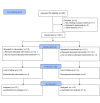Efficacy of Oral Care Protocols in the Prevention of Ventilator-Associated Pneumonia in Mechanically Ventilated Patients
- PMID: 35518542
- PMCID: PMC9064705
- DOI: 10.7759/cureus.23750
Efficacy of Oral Care Protocols in the Prevention of Ventilator-Associated Pneumonia in Mechanically Ventilated Patients
Abstract
Background: Ventilator-associated pneumonia (VAP) is one of the most common infections in intubated intensive care unit (ICU) patients. Oral care with chlorhexidine is a conventional method for maintaining hygiene. Recently, adjuvant methods have been introduced into routine oral care, including teeth brushing and the application of moisturizing lotion. The objective of this study was to compare the incidence of VAP in critical care patients receiving oral care with and without manual teeth brushing and the application of moisturizers to the mouth.
Methods: We conducted a prospective randomized control study comprised of 220 ICU patients between 18 and 65 years of age, and of either sex. The patients were divided into two groups of 110 each. Care for the study group (group S) consisted of chlorhexidine wash, tooth brushing, and moisturizing gel over gums, buccal mucosa, and lips. The control group (group C) was treated with chlorhexidine wash only. The oral assessment was done at 4, 6, 8, and 12 hours using the Beck Oral Assessment Scale (BOAS). Pneumonia was assessed based on abnormal chest x-rays, fever, chest auscultation, endotracheal culture report, and the incidence of VAP, and mortality was observed Results: Abnormal chest x-rays, positive auscultatory findings, fevers, and positive culture reports were significantly reduced in group S compared to these measurements in group C. The incidences of VAP and mortality were also significantly lower in group S compared with the incidences in group C.
Conclusions: Oral care with chlorhexidine mouth wash and the adjuvant measures reduced VAP and, consequently mortality and hospital stays. Tooth brushing along with standard oral care provides an additional advantage in the prevention of VAP in mechanically ventilated patients. Compulsory tooth brushing, if included in regular oral care yields better results in terms of decreased incidence of VAP, length of ICU stay, and mortality.
Keywords: boas score; chlorhexidine; control group; dental plaque; oral hygiene; ventilator associated pneumonia.
Copyright © 2022, Singh et al.
Conflict of interest statement
The authors have declared that no competing interests exist.
Figures
Similar articles
-
Chlorhexidine and tooth-brushing as prevention strategies in reducing ventilator-associated pneumonia rates.Nurs Crit Care. 2011 Nov-Dec;16(6):295-302. doi: 10.1111/j.1478-5153.2011.00465.x. Epub 2011 Jul 26. Nurs Crit Care. 2011. PMID: 21999420 Review.
-
[Ventilator bundle guided by context of JCI settings can effectively reduce the morbidity of ventilator-associated pneumonia].Zhonghua Wei Zhong Bing Ji Jiu Yi Xue. 2017 Jul;29(7):624-628. doi: 10.3760/cma.j.issn.2095-4352.2017.07.010. Zhonghua Wei Zhong Bing Ji Jiu Yi Xue. 2017. PMID: 28743340 Chinese.
-
The effect of different oral hygiene treatments on the occurrence of ventilator associated pneumonia (VAP) in ventilated patients.J Infect Prev. 2015 Mar;16(2):76-81. doi: 10.1177/1757177414560252. Epub 2014 Dec 10. J Infect Prev. 2015. PMID: 28989405 Free PMC article.
-
Does an oral care protocol reduce VAP in patients with a tracheostomy?Nursing. 2013 Jul;43(7):18-23. doi: 10.1097/01.NURSE.0000428709.81378.7c. Nursing. 2013. PMID: 23778208
-
Oral hygiene is an important factor for prevention of ventilator-associated pneumonia.Acta Clin Croat. 2014 Mar;53(1):72-8. Acta Clin Croat. 2014. PMID: 24974668 Review.
Cited by
-
Association Between Daily Toothbrushing and Hospital-Acquired Pneumonia: A Systematic Review and Meta-Analysis.JAMA Intern Med. 2024 Feb 1;184(2):131-142. doi: 10.1001/jamainternmed.2023.6638. JAMA Intern Med. 2024. PMID: 38109100 Free PMC article.
-
Comparison of the effect of licorice and chlorhexidine mouthwash on the oral health of intubated patients in the intensive care unit.BMC Oral Health. 2024 Jun 12;24(1):682. doi: 10.1186/s12903-024-04456-7. BMC Oral Health. 2024. PMID: 38867216 Free PMC article. Clinical Trial.
-
Evaluation of brushing efficiency in reducing oral microbiota in mechanically ventilated patients admitted to an intensive care unit.Infect Prev Pract. 2024 Feb 3;6(1):100346. doi: 10.1016/j.infpip.2024.100346. eCollection 2024 Mar. Infect Prev Pract. 2024. PMID: 38380354 Free PMC article.
-
Prevention of Pneumonia due to Ventilator in Critical Patients with U Shape Oral Hygiene Model: A Systematic Review.Rom J Anaesth Intensive Care. 2023 Apr 20;30(1):1-9. doi: 10.2478/rjaic-2023-0001. eCollection 2023 Apr. Rom J Anaesth Intensive Care. 2023. PMID: 37635851 Free PMC article.
-
The Influence of Oral Health on Comprehensive Health Outcomes in Critically Ill Patients.Cureus. 2025 Feb 6;17(2):e78605. doi: 10.7759/cureus.78605. eCollection 2025 Feb. Cureus. 2025. PMID: 40062016 Free PMC article.
References
-
- Guidelines for preventing health-care-associated pneumonia, 2003. Tablan OC, Anderson LJ, Besser R, Bridges C, Hajjeh R. https://www.cdc.gov/mmwr/preview/mmwrhtml/rr5303a1.htm MMWR Recomm Rep. 2004;53:1–36. - PubMed
-
- The pathogenesis of ventilator-associated pneumonia: its relevance to developing effective strategies for prevention. Safdar N, Crnich CJ, Maki DG. http://rc.rcjournal.com/content/50/6/725.short. Respir Care. 2005;50:725–739. - PubMed
LinkOut - more resources
Full Text Sources

